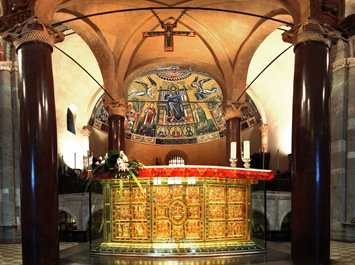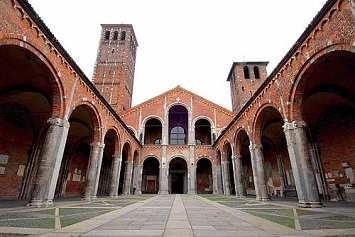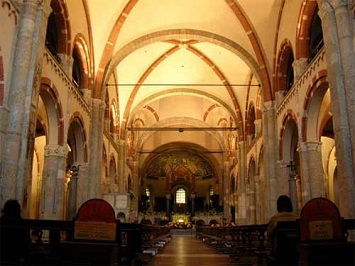NATIONAL MUSEUM OF SCIENCE AND TECHNOLOGY OF LEONARDO DA VINCI

MATERIALS
POLYMERIC MATERIALS
Polymeric materials are synthesis materials which, since the last century, have greatly changed the world we live in and without which today the world would not be as we know it. Industry, indeed, uses polymers to create plastic materials and synthetic rubber, but also to produce fibres, adhesives and glues, varnishes and paints. The Polymer Materials Section is made up of three areas, dedicated respectively to rubber, plastic materials and adhesives. It analyses the history and technological evolution of each material, the chemical, physical and technological properties, the processing techniques, the fascination and impact on our daily life, the possibility of recycling products.
Areas:
- Rubber
- Plastics
- Adhesive substances
COMPOSITE MATERIALS
Composite materials are made of two or more simple but chemically different materials, like polymers, metals or ceramics. Their main characteristic is that they have very different properties compared to materials used to create the material.
Also if some of them already exist in nature, like wood and bones, composite materials are generally created by human hand, based on need. One of the most ancient is paper and the most used is cement.
Areas:
- Paper
METALS
Metal is a natural substance that is usually found in minerals. To obtain metal it is first necessary to extract it from its ores, that is, separating it from other substances and refine it to a certain purity. Alloys are materials made of two or more elements, in which at least one component is a metal.
There are hundreds of different metals and alloys, each one with different properties. However, they are all stiff and resist deformation, have high electric and thermal conductivity, are not transparent to light and can reflect it. Metal can be worked – by plastic deformation, casting or sintering – in order to produce a lot of different objects. At the end of object life, metal can be recycled infinitely without losing its original properties. On the contrary, they can even be enhanced.
The exhibition is dedicated to Steel, Aluminium and Copper. It illustrates the metal extraction and processing techniques through the machinery used and the products created.
Areas:
- Steel
- Aluminum
LIFECYCLE OF PRODUCTS
Every day new products are designed, created and transported to their destination, where they will be used. When the time comes to get rid of them, it means that they have served their purpose, but the resources they are made of can enter into an exchange with the environment at this point. In fact, the energy and raw materials that go into making products initially come from the environment, and that is where they go back to as waste and emissions. Getting to know our products better means knowing more about their life-cycle and their environmental, economic and social impact. In this section, the design stage shall be the starting point in our exploration of the four stages that make up a product’s life-cycle: manufacturing, distribution, use and disposal.
TopBASIC CHEMICAL MANUFACTURING
The area tells the story of chemical transformations, from basic elements to everyday products. Visitors can discover the many substances that form the world around us. Can we obtain bread from air? Oil from perfume? Credit cards from sea salt? Creativity of molecules, processes, reactions, safety, health and environment: there is an infinity of key words in this new world. The exhibition aims to situate the chemical industry in the frame of today’s world, highlighting its technical and scientific aspects and its connection with individual and social habits.
TopTRANSPORT
AIR TRANSPORT
The collection runs through the history of flying, from pioneering times to jet aircrafts. The Air & Water Transport Building has eleven aircrafts on exhibition. Among these: the first Italian fighter Macchi-Nieuport Ni10 (1915) , the Macchi 205V which has been perfectly restored with its original livery from the 40s and the Vampire MK52, the first jet fighter aircraft of the Italian Air Force. Among the engines on display are the three-cylinder fan type Anzani engine (1909) and the more common radial engines. Outside there are three jet aircrafts from the post WWII like the G91R (1957), renowned fighter and ground attack aircraft for reconnaissance photos.
Areas:
- Helicopters
RAIL TRANSPORT
The collection is displayed in a pavilion from the 1906 Expo with an added reconstruction of a late 19th century railway station façade. It shows one hundred years of rail transport evolution beginning from the second half of the nineteenth century. In the Rail Transport Building you can see some vehicles from the history of public transport in Lombardy: a horse-drawn tram (1885), the mythical Gamba de Legn, "Wooden Leg", (1909) which linked Milan to Trezzo d'Adda and one of the first convoys of the Ferrovie Nord Milano (North Milan Railways). You can also see various steam locomotives produced in Italy between the end of the nineteenth century and the mid-1930s, among which is the 691-022 steam locomotive with tender (1914). A series of electric engines still in use until the end of the 1960s show the technological evolution of rail transport.
TopWATER TRANSPORT
This section introduces the theme of navigation and displays the Museum’s relics together with those of the Milan Didactic Naval Civic Museum. Here are some of the most striking historical objects of the museum’s collections: the brig schooner Ebe (1921) and the command bridge of the transatlantic liner Conte Biancamano (1925). The bow of the Stella Polare (Polar Star) ship tells us of the first expeditions to the North Pole. Some assault crafts used during the world wars, among which the Maiale (“pig” as the manned slow-speed torpedoes were known), show the courage of the seamen. The history of the great battles is told through the models of reknown sailing vessels for their achievements. The Air & Water Transport Building also hosts a collection of figureheads, objects and books on naval matters donated by the Milanese editor Ugo Mursia.
TopTOTI SUBMARINE
How could 30 submarine seamen live for weeks under the sea? What did they do? What was the role of this submarine during the Cold War? Launched in 1967, the submarine Enrico Toti was the first to be built by Italian shipbuilders since the Second World War. In its thirty years of service in the Mediterranean Sea it travelled 137,000 miles. During the guided visit on board, among the engine room, the sonars and the periscope, you can experience the emotions of the seamen during their long voyages.
TopENERGY
ENERGY SOURCES AND DEVICES
The department collection is spread out, due to size and functions, from the Museum entrance to outside areas. Indeed it includes complete plants, both historic and modern, such as the Regina Margherita thermoelectric power station (1895) and a 3-kW photovoltaic field linked to the network. The hall located on floor -1 of the Monumental Building has the task of offering an overview of energy sources and related devices. The exhibition is constantly being updated and has various areas. The first to be renovated is dedicated to oil and its industry. The others “under construction” concern gas, renewable energies (in particular water, sun and wind), coal and its historic link with steam, nuclear energy. At the centre of the hall, important historic objects offer glimpses into the history of Italian energy. Audiovisual material is also available on themes linked to the exhibition.
TopENERGY SYSTEM
The department collection is spread out, due to size and functions, from the Museum entrance to outside areas. Indeed it includes complete plants, both historic and modern, such as the Regina Margherita thermoelectric power station (1895) and a photovoltaic field linked to the network. The hall located on floor -1 of the Monumental Building has the task of offering an overview of the energy system and of its evolution, due to governments directives and development programmes, but also to ideals and initiatives by the single person. Starting from sources, grids, networks and consumers -the “things” of which the energy system is made up of- the exhibition shows and analyzes some changes connected with the evolution of the energy system: some of them have already come into our homes, others involve Italy, Europe and the entire World. A central role is given to energy forecasts for the future and to the jungle of different opinions that surrounds change to the energy system.
TopCOMMUNICATIONS
TELECOMMUNICATIONS
This section displays the history of instruments used to communicate from a distance from the optical posts at the end of the 18th century to optical fibres. This new exhibition opens with an area dedicated to the history of the telegraph. In the same hall, on a parallel route, the past and the present of the telephone are analysed. These two areas are enriched by the presence of some rare antiques such as the Caselli’s Pantelegraph and the Meucci’s telephones. The network concept is then analysed, a fundamental structure to connect many users. Thanks to the original devices with which Marconi started his experiments on radiotelegraphy, you can study more deeply the theme of wireless reception. Small amateur devices, public state systems and the study of a private radio broadcaster explain the theme of radio broadcasting. This section is completed with the area dedicated to the evolution of television technology. Some faithful reconstructions of the historic television production and reception places will accompany you to Piazza della Comunicazione – Piazza Telecom Italia, "Communication - Telecom Italia Square", the place where all the medias converge and create the modern and revolutionary ICT digital world (Information and Communication Technology).
TopSPACE
Two strong effect objects open the area, the celestial and terrestrial Moroncelli globes that came from XVII century. They show to visitors the main characters of expo, in addition to human: the Space and the Earth. Both objects are animated by a video installation with scenic and contemporary pictures that show the Earth seen from the Space (near the terrestrial globe). Storic objects together with the modernity of the pictures makes clear a connection between the past, present and future. Behind the globes there’s the Foucault pendulum, a storic reproduction near a digital animation of the Earth rotation experiment that shows you that Earth is part of a system that need examination and comprehension.
TopLEONARDO ART&SCIENCE
LEONARDO DA VINCI
The Museum’s collection of historic Leonardesque models was created to celebrate the fifth centennial of Leonardo’s birth. A group of experts was nominated to study Leonardo da Vinci’s manuscripts in order to create the models which were displayed for the first time in 1953. In Leonardo’s drawings there are not only projects of machines to be built but also observations of existing works, suggestions for improvement or studies on nature. The models on display are the fruit of a reinterpretation which has translated and completed his drawings. The historic layout of the Leonardo Gallery, where the exhibition of the models is enriched with a series of drawings from his numerous fields of interest, is completed with an exhibition that examines more closely his Milanese years.
TopJEWELLERY
The collection shows a selection of precious objects starting from stones, gems and metals. Objects made in gold, ivory and jade witness the importance of these materials, symbols of economic, religious and social power. The creation by the goldsmith Ravasco opens the display dedicated to the production of jewels. A goldsmith’s workshop shows all the working phases.
TopHOROLOGY
This section shows the evolution of instruments to measure time, from the Egyptian hourglass to the quartz watch. The Bertolla workshop introduces the area dedicated to the making and use of the clock. On display, pendulums and apartment clocks, personal watches and tower mechanisms. The reconstruction of the Dondi Astrarium (an astronomical clock) is able to read the position of the Sun and planets according to the Ptolemaic system.
TopMUSICAL INSTRUMENTS
This collection displays instruments produced between the 17th and 20th centuries. Most of the objects were donated by Emma Vecla, a singer from the beginning of the 20th century. It consists of string instruments such as violins, violas, viola d’amore, and cellos. In addition, other plucked and stroked string instruments are on display: guitars, barrel-organs and pianos. Part of the exhibition is dedicated to wind instruments: flutes, clarinets, oboes and English horns. Objects of great value are an Erard piano (1830 approx.), an Erard harp (1835) and a Giosuè Agati positive organ (1826). You can discover the making phases of a violin and observe the reconstruction of a lutemaker’s workshop from the 17th century.
TopLABORATORIES
NUTRITION
SCIENCE FOR YOUNG PEOPLE
NANOTECHNOLOGY AREA
Have you ever handled an atom?
Did you know that you're a nano?
Have you ever looked for the nano-world?
This is a real nanotechnology research lab open to all.
It is a place where you can understand if and how nanotechnology will change our lives and where you can discuss its potential risks and benefits.
Researchers of CIMAINA of the Università degli Studi di Milano are studying the properties of nanostructured materials. You can see them in action, meet them and have a chat.
You will have the opportunity to observe scientists at work, interact with them and discover the world of nanotechnology through nano products, interactive exhibits, audiovisual facilities and educational activities.
You are invited to come to the museum and "disturb" the researchers, to understand what is nanotechnology and express their point of view. The applications of nanotechnology research are numerous and diverse.
In the Open Nano Lab at the National Museum of Science and Technology, CIMAINA researchers will study the properties of some nanostructured materials such as titanium dioxide and carbon, determining which electrochemical reactions occur on their surface and how these processes are influenced by light. These nanomaterials can be applied in different devices: for example in photovoltaic cells for producing electricity from sunlight, in supercapacitors that store electrical energy or in cells for the production or exploitation of hydrogen.
SAINT AMBROGIO'S CHURCH
The Church of St. Ambrogio is one the most ancient churches in Milan and it’s located in St. Ambrogio Square. It represents a paleochristian and medieval monument and a important piece of Milanese history. This Milan church is also one of the most important ones.
«Vostra Eccellenza, che mi sta in cagnesco
Per que’ pochi scherzucci di dozzina,
e mi gabella per anti-tedesco
perché metto le birbe alla berlina,
o senta il caso avvenuto di fresco,
a me che, girellando una mattina,
capito in Sant’Ambrogio di Milano,
in quello vecchio, là, fuori di mano.»

The church was built between 379 and 386 by bishop Ambrogio’s request, and it’s made with poor materials with local origins: with them were made also peripheral buildings.
They added to the pyx, built between Xi and X centuries, four apex decorated with stucco in X century and they are still well preserved since that time. Under the pyx there’s the St. Ambrogio altar, from the Carlo Magno Era, made of gold, silver, precious stones and varnish and it keeps inside the corpses of two saints and St. Ambrogio.
The main façade shows two loggias. The lower one has three arches and rejoin the inner perimeter of the portico, and the upper one has five arches that follows the sloping roof profile.
There are elegant arches supported by columns and colors underline every part of the portico. The arches have a double ferrule and the frames are sustained by small archs like the ones on the façade, and thin pilasters separate the upper surfaces properly.
The cript is situated under the main altar and it was built the second half of the X century, during the renovation church absid, to keep in a better way the bodies of the saints Ambrogio, Gervaso and Protaso.
In the floor of the cript there is a gravestone in memory of the place where it was buried Ambrogio’s sister st. Marcellina. Later her corpse was moved in the right nave, in a dedicated chapel.


Top